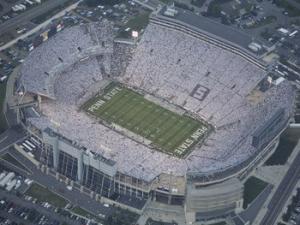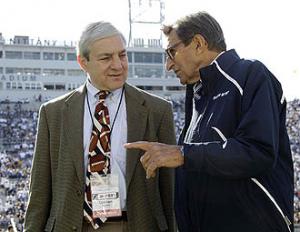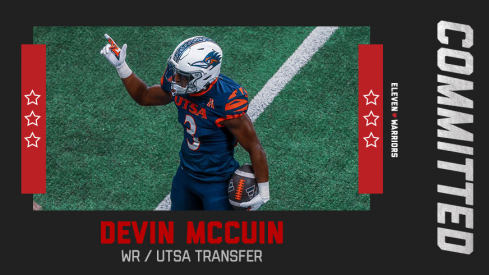Legions of fans flock to college football stadiums – cathedrals in some of their eyes – each Saturday in the fall. It’s the romanticized view of college football that drives many of them to remote outposts like Laramie, Wyo., Manhattan, Kan., and State College, Pa.
The pageantry and tradition brings alumni and fans back year after year. From the fight songs to the camaraderie among old friends, college football provides a link from the past to the present to the future.
Take in a game at Ohio Stadium and your ears will be ringing with shouts of “O-H” “I-O” for weeks; in South Bend, Ind., the Notre Dame Victory March seems to play on repeat; and Beaver Stadium’s anthem of choice are shouts of “We Are…Penn State!”
They can rephrase that now. We were Penn State.
After Monday’s landmark decision by the NCAA against the Nittany Lions’ football program, the artist formerly known as Penn State looks little like the powerhouse Joe Paterno and Jerry Sandusky built over four decades. Left in the ruins is Youngstown State East.
Despite the harshness of the penalties and the NCAA setting new boundaries of power, association president Mark Emmert should be lauded for taking a stand and delivering swift and decisive action against an institution and program responsible for the largest scandal in the history of intercollegiate athletics.
The NCAA is about as unpopular with the American public as the Internal Revenue Service, but “We the people” got exactly what we wanted on Monday: the NCAA to deliver a knockout punch to not only a serious offender, but one of college football’s powerbrokers.
Consider it the “Death Penalty” without the dying part – or the Zombie Penalty.
- $60 million fine
- Significant scholarship reductions
- Four-year postseason ban
- Vacation of wins for 14 years
 Penn State's famed "whiteouts" might take a vacation.
Penn State's famed "whiteouts" might take a vacation. The arguments will continue for decades about whether the NCAA overstepped its means, or if the penalties were too severe or too lenient. But Emmert appropriately said the circumstances surrounding the case were “completely different from other enforcement cases.”
“The great challenge that we spent most of our time on was, how do you craft sanctions that have the intended effect,” Emmert said. “Clearly, this calls for a punitive action, but it also calls for corrective action, to enable and also ensure that the kind of culture change occurs that is necessary at Penn State University, and, at the same time, has minimal impact on innocent parties.”
One thing is certain, Penn State has been decimated and the reputation of the university has been harmed greatly. Paterno, as revered and legendary a figure as there has been in all of sport, is at the center of the scandal that Emmert said “strikes at the very heart of what intercollegiate athletics is all about.”
When a football coach is more powerful than the governor, and he, the university president and athletics director are all involved in an intricate cover up of a serial pedophile, a culture change of epic proportions is needed. And that’s what has occurred since November at Penn State.
The Freeh Report gutted the community and led to the Paterno statue outside Beaver Stadium being removed. In the background, the NCAA sat by idly before Emmert’s iron-fist ruling came down. The importance of winning at Penn State was changed immediately when the NCAA doled out its sanctions.
“For the next several years now, Penn State can focus on the work of rebuilding its athletic culture, not worrying about whether or not it’s going to a bowl game,” Emmert said.
 It's almost as if Paterno was never the head coach at PSU.
It's almost as if Paterno was never the head coach at PSU. Emmert and Ed Ray, chair of the NCAA’s executive committee and the Oregon State president, made it clear on Monday that the tides have changed at the NCAA and that the association took its role very serious. The scope and magnitude of the Penn State scandal warranted both swift and stern action.
Much like the fans that have been fed up with inaction by the NCAA and countless scandals over the past two years, presidents and chancellors also grew frustrated. In one gathering, Ray said the consensus among his peers was, “We’ve had enough. This has to stop.”
Apparently they meant it.
“Does this send a message?” Ray said. “The message is the presidents and chancellors are in charge.”
Ray continued: “The cautionary tale is that every major college and university needs to do a gut check and ask where are we on the appropriate balance between the culture in athletics and broader culture of the university and make certain they’ve got the balance right, and if not, to take corrective action.”
Since 1998, those at high-levels at Penn State believed the image of the university and Paterno’s grand football factory were more important than the well-being of the youth of Centre County, Pa. It would have been too much for the community to bear if word spread that Sandusky, a legend in his own right at Penn State, was a child molester. It could have caused irreparable harm to Paterno and the football team if Sandusky was indeed inappropriately touching children at the football facility.
The trio – Paterno, former president Graham Spanier and athletics director Tim Curley – lost their jobs for their gross deeds. Now, the football program will be under water for at least a decade, giving the fans and university more important matters to worry about.
 Spanier and Paterno's involvement in a cover up was shocking.
Spanier and Paterno's involvement in a cover up was shocking.Perhaps the biggest or most symbolic penalty, however, wasn’t about scholarships, bowl games or money; it was the vacation of the Nittany Lions’ and Paterno’s wins dating to 1998.
One hundred eleven in all.
It takes Paterno from 409 victories and the winningest coach in major college football history to 298 wins. Bobby Bowden now sits atop the all-time wins list. Paterno, meanwhile is No. 12. The incoming freshman haven't seen a Penn State win since they were four-years-old. For Penn Staters, Paterno’s status and wins record were the almighty. Paterno, stubbornly, refused to retire for years in part because of the chase he and Bowden were in to be the winningest coach. To take a record that meant so much to all involved is just as gut-wrenching as imploding the entire program.
The record book now says Paterno’s last victory came on Nov. 22, 1997 when Penn State defeated Wisconsin. The quarterback for Penn State: Mike McQueary. Irony at its finest.
Caught in the middle today are current Penn State players. They didn’t sign up for scandal. Instead, they enrolled at Pennsylvania’s big state university because of a legendary coach, historic football program and sterling academics. All but one of those are now lost.
Some point out that they don’t deserve to be punished, and there is certainly merit to that argument. However, they are allowed to transfer to any university without sitting out a year, an out-clause of sorts that they warrant. Silly season has already commenced for those still on the PSU roster. Schools from around the country are circling the waters in anticipation of a mass exodus.
“We don’t want to restrict a young man’s choice of schools,” Kevin Lennon, the NCAA’s vice president of academic and membership affairs, said. “They obviously find themselves in a very difficult situation. Should they already want to go a program that’s already at 25 (scholarships for the year) or at 85 (total), that’s something we would work through with that individual institution.
“Our key approach to this is we’re trying not to limit opportunities that students would want to pursue academically and athletically.”
With all the talk about change, though, from the NCAA and administrators throughout the country, therein lies the problem: win at all costs.


